Cecily Wolfe's Blog: The Start of Something New - Posts Tagged "in-the-margins"
In the Margins - Upcoming Blog Tour
Happy Monday!
A new week, and a new opportunity to find great books to read! Some of you know that I am a young adult librarian as well as an author, and one of the book award lists I find very helpful when searching for stories to share with my teen readers is the In the Margins award. My book That Night was considered last year, but did not make the list. It was an honor just to be on their radar!
They are starting a blog tour soon featuring books that made the top ten lists as well as those they recommend for young readers 'in the margins' - in custody/foster care, in poverty, or part of a marginalized population, as well as adults who work with them, like teachers, librarians, and counselors/social workers. Be sure to keep an eye out here on my blog as well as these sites for more details, including readings and interviews.
You can find more details about the In the Margins award here: https://inthemarginssite.wordpress.com/
I discovered some of my favorite authors, like P.D. Workman, from this list.
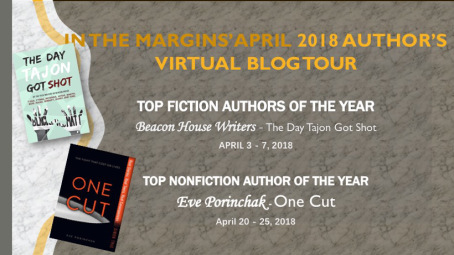

A new week, and a new opportunity to find great books to read! Some of you know that I am a young adult librarian as well as an author, and one of the book award lists I find very helpful when searching for stories to share with my teen readers is the In the Margins award. My book That Night was considered last year, but did not make the list. It was an honor just to be on their radar!
They are starting a blog tour soon featuring books that made the top ten lists as well as those they recommend for young readers 'in the margins' - in custody/foster care, in poverty, or part of a marginalized population, as well as adults who work with them, like teachers, librarians, and counselors/social workers. Be sure to keep an eye out here on my blog as well as these sites for more details, including readings and interviews.
You can find more details about the In the Margins award here: https://inthemarginssite.wordpress.com/
I discovered some of my favorite authors, like P.D. Workman, from this list.


Published on March 12, 2018 07:59
•
Tags:
blog-tour, book-awards, in-the-margins, itm, marginalized, nonfiction, povery, teen-fiction
Beacon House Writers: In the Margins Blog Tour, Author Interviews

The Beacon House Writers are ten teen writers who are members of a community-based organization in the Edgewood Terrace community of NE Washington, DC. The mission of the organization is to lift as many children as possible up and out of their often difficult circumstances. Shout Mouse Press collaborates with Beacon House giving agency to the teen writers’ voice. In 2017 ten authors worked together to finish a 2-year collaboration with Shout Mouse Press resulting in The Day Tajon Got Shot, which went on to gain national attention and win Top Fiction credentials for In the Margins 2018 Award List. Three of those ten authors (T’Asia, Temil, and Rose) are featured in a mush anticipated interview below as part of our April book blog tour.
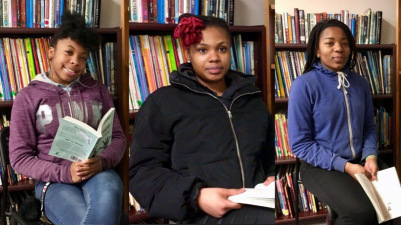
Can you tell us a little bit about yourself?
Rose: I am 16 years old. I attend Don Bosco Cristo Rey High School in Takoma Park, MD. I like to play basketball. When I’m not writing, I’m reading.
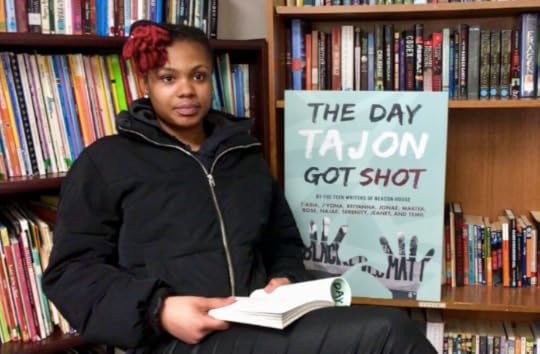
T’Asia: I’m currently a freshman at Banneker High School in Washington, DC. In my free time I usuallyhang with friends & go places. Sometimes when I don’t do that I draw. I also cheer.
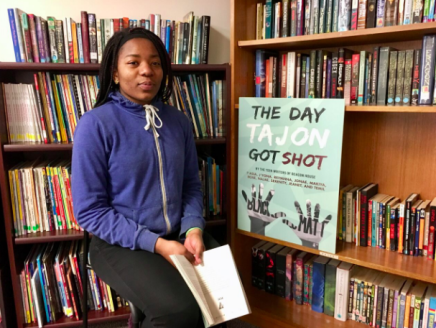
Temil: I am 16 years old. I attend Dunbar HS in Washington, DC. When I’m not writing I tend to hang out with my friends. I also work with a program called Reach Incorporated after school. At Reach I tutor young kids on their reading comprehension skills.

Were you into writing before you started on the Tajon project”? What were some of your earliest memories of writing that you enjoyed?
T’Asia: I used to write poems in my free time or write about my life but I never thought of writing a book.
Temil: Yes, before I wrote this book I wrote another one with Shout Mouse called Trinitoga: Stories of Life in a Roughed-Up Tough-Love No-Good Hood. It’s a novel about a neighborhood we made up in DC and the people who live there. Before I started writing with Shout Mouse I wasn’t really interested in writing. But I did enjoy and still do enjoy writing essays for school.
When you started on the Tajon Got Shot project, can you share with us what you did to come up with the idea?
Temil: I used things that were happening in the world. When we started writing there was a lot of news about police brutality involving black young men so we wanted to voice our opinion about it.
Can you tell us about some of your challenges in writing Tajon?
T’Asia: Some challenges I had to deal with was being in somebody else’s shoes & figuring out how the story will flow.
Temil: Some challenges I had was determining what happens next due to the fact that I had to be mindful of others’ opinions.
How did you determine the storyline? What was your process? Did you have to make an outline or are do you just write?
Rose: My process was to think about what and how I wanted my character to be. I got into the head of the cop and how I wanted the cop to think. We didn’t use an outline. We just wrote our ideas down and brainstormed with the group. Everybody had to be on the same page.
Temil: I really just wrote what I wanted to happen each day. We didn’t make outlines, we just had conversations amongst each other about what we wanted to happen next.
Characters? Which characters voice were you? What did you have to do to prepare for writing the character (s) you represented. What about the process made it the hardest? What about it did you enjoy? Is anything or anyone in your book based on real-life experiences or purely all imagination?
Rose: I wrote the character Pete the Cop. I had to think how a cop would feel if it was a real situation. We looked at some articles about cops in real life who were in this situation and that helped me come up with my ideas. I enjoyed seeing both sides of the story. But it was hard to put my words together. I don’t have a problem with cops in my own life, so I don’t see them as the enemy. But I don’t think that they should just go around shooting people, especially when they are innocent.
T’Asia: I was the character Ashley, the cop’s daughter. I prepared for this by basically watching my surroundings & trying to fill her shoes. The fact that she is white made it hard for me to understand her. Also my dad is not a cop so I don’t know how to feel in that situation. I enjoyed seeing how the whole story played out. One particular part related to me. I have a deeper connection with my dad than my mom & I just used how I would react in that situation.
Temil: I was the voice of Tajon. In order to prepare for writing about this character I had to put myself in the shoes of a person living a hard and rough lifestyle. I had to show how it feels to be a young black teenage boy in society during that time. I used experiences about things I knew about police brutality with young black men.
Genre? Is the genre for Tajon, your favorite? Why? Why not? Is there another genre do you more? Why or why not?
Rose: I enjoyed writing fiction because you get to imagine the story. You’re not restricted by any specific facts. This is the only book I’ve written, and I don’t really write in other genres.
T’Asia: Fiction is my favorite because it makes you think beyond the real world. You get to use your imagination. It makes you think outside the box to understand what’s happening in the story.
Temil: Yes this genre is my favorite because it interests me to write about things like this. With fiction you can just say what you want to happen. Anything is possible.
What else have you worked on since Tajon was published?
Rose: This is my first book, but I plan to write more. It would be another book for teenagers, probably about high school life.
T’Asia: Right now I just work on my poetry about my life but I don’t share it with anyone. It’s just for me. It helps me express my feelings. I used to keep my anger inside, but writing has helped me get through a lot of things.
Temil: Last summer I worked on another book with Shout Mouse and Reach Incorporated called Spanky the Pup: All Dogs Must Go. It’s a children’s book, for younger kids. It was inspired by thinking about kids in the foster care system, how they don’t always feel wanted.
Can you share with us a book you’ve read that has made an impact and why? What book did you last read? What book are you currently reading?
Rose: I really liked the book Things Fall Apart. It really kept my attention and made me want to read more by that author.
T’Asia: A book I read that made an impact on me is Lord of the Flies. It made me think more deeply about government and things that happen in the real world. Right now we’re reading Romeo and Juliet in school.
If you had to go back and do it all over, is there anything that you think you’dchange pertaining to the story?
Rose: I would love to write from another perspective, especially Tajon’s mother. I’d like to see how mothers would feel in this situation. It would be so hard on them that their child is shot. No mother should have to go through that.
T’Asia:I still feel like Tajon should not have died. The fact that he died meant that the conflict ended, and there was no real solution. Nobody found out the truth, because only he could have told the truth. Maybe that could have led to Pete being convicted. It’s like in real life. There’s no real solution, people don’t find out what actually happened, because the people who are shot so often die. They don’t get to tell their story.
Temil: Personally I would change the fact that Tajon dies. I want to see what would happen to him if he lived.
What was your favorite chapter (or part) of the Tajon storyline and why?
Rose: My favorite part is writing about Pete, especially the scene when he goes to the hospital. In real life cops would feel sad to see the person they shot.
T’Asia:I liked the part where Kayla rioted. She stood up for what she believed in. It was also really powerfully written.
Temil: My favorite chapter was about Bobby the drug dealer because it showed why the character did what he did.
What has been the toughest criticism given to you as an author? What has been the best compliment?
Rose: The best compliment I’ve heard is that we have made a big impact on our readers. When we give readings, the audience really enjoys it, and they give us good feedback. It’s good to see that the young kids read our books. I think they think of us as role models.
T’Asia: It’s not exactly criticism, but sometimes we had to delete scenes that we’d written and that was hard because I felt like some of that was really good. But it contradicted with what others had written, so it couldn’t be included.
Do you have any advice to give to aspiring writers?
Rose: My advice is to be yourself and think outside of the box.
T’Asia:Always believe in what you write. Stick to what you believe in. As you keep writing, think about how it could help others. Always have a message.
Temil: While you’re writing, become another person. Moreso, get out your comfort zone and become what you are designed to write about. Make sure you involve different perspectives that can be part of your story.
Is there anything that you would like to say to your readers and fans?
Rose: I would like to say thanks for supporting us and our book.
Tamil: Writing this book has made a big impact on me because it shows you what others have to go through just to get through life. It shows you that just because someone is doing something bad may not actually make them a bad person. They may have gone through things in life that you didn’t, but you should try to understand.
Thank you so much for the giving of your time.
Published on April 07, 2018 04:36
•
Tags:
awards, blog-tour, in-the-margins, interviews, marginalized-youth, middle-school-books, teen-authors, teen-fiction, teen-writers, young-adult-fiction
Interview with One Cut's Author Eve Porinchak - In the Margins Blog Tour
Once again, I am happy to be a host for this month's In the Margins blog tour. Yesterday I posted on my website with details on One Cut, a YA true crime book that was a top pick for the In the Margins list this year, and today our feature is an interview with author Eve Porinchak.
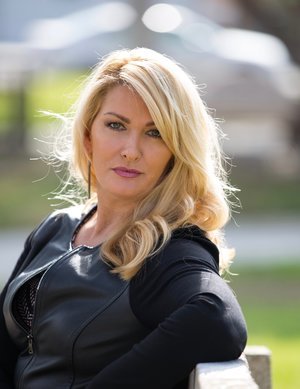
ITM: Can you tell us a little bit about yourself?
EP: I was a severe reluctant reader as a kid. Like, to the point where I made stuff up when I had to write book reports because I could never finish a whole book. I was slow reader with low comprehension and embarrassed to tell anybody. I had a family full of super smart obsessive speed-readers who devoured books. However, I did love Mad Magazine and The Family Circle comics, so that’s where I really learned to read. Strangely, I loved writing and spent much of my childhood in my room propped up against my orange vinyl toy box writing and illustrating my own hilarious books. But it wasn’t until I went to medical school that I actually learned how to “read” properly and digest and comprehend efficiently. I always said that I would someday write books that I would have liked to read when I was a kid. Now I’m doing that!
ITM: Is writing your only profession? What do you do when you are not writing? If so, how does that tie into your writing?
EP: I work full time in the Los Angeles children’s dependency court, recruiting and training guardians appointed to foster youth. It’s intense, but I love it! I’ve worked with foster youth, gang kids, orphans in Baja, and incarcerated teens for many years in various capacities, as a creative writing teacher, advocate, and social worker. This is where all of my writing comes from, both fiction and nonfiction.
When I started learning to write kid’s books in 2002 I was struck by the appalling lack of characters who came from marginalized populations. I’d worked with gang kids and those from the inner city for as long as I could remember. Yet, we could rarely find books that reflected their experiences. MONSTER by Walter Dean Myers is a huge exception . . . it’s the most riveting and realistic book I’ve ever read! I’m committed to writing about the “forgotten” youth.
Kids who are locked up, or in foster care, or who crossed the border into America alone and illegally. Because I had such a stable life growing up, I was always drawn to kids who had the opposite. I always knew that their stories could have been mine. Circumstance gave me the winning lottery ticket.
I started writing their stories, both fiction and nonfiction, and talking with editors about the “real” America that many don’t see. Still, there was a perception that nobody would care to read these stories. Thank god for the WE NEED DIVERSE BOOKS movement. These kids. These forgotten, invisible, underrepresented kids need to see books about themselves. As long as they give me permission to tell their stories, I will. The idea that kids who are poor or kids who are marginalized don’t read is ludicrous. Finally, the KidLit publishing world is catching up.
ITM: DO YOU REMEMBER WHEN YOU FIRST GOT THE IDEA TO WRITE ONE CUT? CAN YOU SHARE WITH US HOW THAT CAME ABOUT?
EP: I began teaching in LA’s Central Juvenile
Hall and the Sylmar jail (where kids in the compound are waiting to be tried as adults – very much set up like an adult prison) in 2007 through Inside Out Writers. There I met Sharry Holland, a fellow teacher who had two sons who were sentenced to life in prison when they were fifteen and eighteen years old. I had read about these kids – Jason and Micah Holland – back in Randall Sullivan’s 1997 Rolling Stone Magazine article, and was shocked to learn they had lost all appeals and would die in prison. They were good kids, who had grown up just like me in the LA suburbs. After school one day they’d gotten into a backyard fistfight, a pocketknife was pulled out, and one friend accidentally died. Five of the seven boys were arrested and charged with first-degree murder (possibly facing the death penalty!) including one kid who was still in his truck and never even saw the fight. These were teenagers!
I became obsessed with learning everything about the case and devoured all the police files and 7500 pages of trial transcripts. I seriously memorized every detail. And nothing added up. When I pitched the idea for a book to a publisher at Simon and Schuster during a breakfast meeting (where I had tagged along, uninvited) she was riveted. Soon after, I had a contract to write the book.
ITM: WHAT CHALLENGES DID YOU FACE WITH ONE CUT ON THE ROAD TO PUBLICATION?
EP: First, the subject matter is incredibly disturbing because an innocent kid died, and four teenagers (now middle aged) are rotting in prison. That was the toughest part. I visited the boys in the prisons on weekends, and became very close with them. It’s rough watching guys suffering in inhumane conditions, no matter who they are. But, it’s especially sad because these guys – Micah Holland, Jason Holland, Brandon Hein, and Tony Miliotti – don’t belong in there.
Getting all the facts straight and combing through every single word of the book with the Simon and Schuster legal department, to ensure everything is 100% true and accurate, was exhausting and time consuming. But it was so worth it, and I learned a ton about writing nonfiction!
ITM: YOU HAVE WORKED WITH OTHER WRITERS IN YOUR PROFESSION IN SCHOOL AND IN YOUR JOB AT THE LITERARY AGENCY. HAVE YOU EVER HAD TO HELP GET SOMEONE THROUGH WRITER’S BLOCK? HAVE YOU EVER EXPERIENCED WRITER’S BLOCK YOURSELF? DO YOUR SUGGESTIONS TO OTHERS WORK FOR YOU?
EP: Every writer I know has suffered from writer’s block at some point in time. Veteran writers always told us to “write through it.” I found that the opposite helped. When I suffered from two full years of writer’s block, after enduring a traumatic event, I walked away, set down my pen and closed my computer. During that time, I spent many hours, days, weeks, months immersed in the jail system. I still taught creative writing, even though I was paralyzed to write myself. Focusing on my kids, getting to know them on a deep level, and fostering their love of writing and journaling was the greatest thing I’ve ever done. They absolutely saved my life, and healed me. I haven’t stopped writing since. Sometimes, you’ve just got to walk away for a bit.
ITM: IS THERE ANY PARTICULAR AUTHOR OR BOOK THAT INFLUENCED YOU IN ANY WAY EITHER GROWING UP OR AS AN ADULT? CAN YOU SHARE THE NAME OF THE BOOK AND WHY IT HAS BEEN SO IMPACTFUL?
EP: Truth be told, I don’t think I ever finished an entire book until I discovered The Outsiders by S.E. Hinton in the eighth grade. I read it 100 times. My girlfriend Maril Manning and I memorized it, and even dressed like the 50’s Greasers gang during that year (Rockabilly was trending at the time, so we were super cool). It struck a chord with us because we had this pact where we vowed to “friend the friendless” in Junior High while some of our classmates strived for popularity or went the bullying route. If somebody was picked on or new to the school or bizarre and different, we invited them to our lunch tree to eat with us. Soon, our posse grew so massive, we had to improvise with the seating! (Our tree enclosure was not all that large). Because the Greasers in The Outsiders were poor, parentless, and picked on, we felt a deep connection to them. Every kid has been the outsider at some point in his/her life. We promised to never forget that feeling, and always empathize with those while they endured it. Side note – at my 20-year high school reunion, a man approached me and told me that our lunch tree gang were the only people who were ever nice to him during his entire teenage life.
ITM: IF YOU HAD TO GO BACK AND DO IT ALL OVER, IS THERE ANY ASPECT OF YOUR NOVEL OR GETTING IT PUBLISHED THAT YOU WOULD CHANGE?
EP: Not one! I had a fabulous team, generous support, and all went very smoothly. The book really wrote itself, and I loved every single minute of that entire year of researching/writing. My sister, Amy, a public defender who represents kids who are tried as adults, was with me every single step of the way. It was the most fascinating year of my life, for sure.
ITM: HOW DO YOU MARKET YOUR WORK? WHAT AVENUES HAVE YOU FOUND TO WORK BEST FOR YOUR GENRE?
EP: Honestly, I juggle three jobs (social worker, literary agent, and college instructor) so marketing has been my weak spot. Because this is sort of a new genre– teen true crime with a juvenile justice bent – we are still navigating the best avenues to get the book into the hands of teens, parents, teachers, etc.
ITM: WILL YOU HAVE A NEW BOOK COMING OUT SOON? CAN YOU TELL US ABOUT YOUR UPCOMING BOOK? IS ANYTHING IN YOUR NEW BOOK BASED ON REAL LIFE EXPERIENCES LIKE ONE CUT, OR PURELY ALL FICTION?
EP: I’ve got another nonfiction project about a young girl who was bullied to death, which is out for consideration. Very intense subject matter, but wildly important reading, I think. I’ve also got two fiction books, one middle grade adventure about foster youth and one young adult contemporary story about incarcerated kids in an innovative writing program. Both the fiction stories are full of humor and tragedy, but mostly humor. It’s a nice change for me.
ITM: WHAT WAS YOUR FAVORITE CHAPTER (OR PART) TO WRITE IN ONE CUT AND WHY?
EP: I was happy (and sad) to write the ending. Although the boys are still locked up, I have tremendous hope for a miracle. I’ve felt it in my gut that something is going to change, and they will be set free. That said – NEWS ALERT – Tony Miliotti, one of the boys initially sentenced to life without parole (who never threw a punch, but only watched the fight) was miraculously granted release LAST WEEK! I do not have details on how exactly it transpired. But, it gives me great hope for the other three, when it seemed for twenty-three years that all hope had been lost.
Brandon's Letter, March 2018

This is a recent letter from Brandon Hein that mentions Tony’s release. The letter is posted in an update on his website “Heinsight” (http://www.brandonheinart.com/). Brandon is a graphic artist and uses his website as a digital gallery for the art he produces. Some of his work has been featured in special art shows for incarcerated populations. It is also available for sale in print formats and as original pieces.
ITM: HOW DID YOU COME UP WITH THE TITLE, ONE CUT?
EP: My original title was Cruel and Unusual, because I believe that sentences of LWOP – life without parole – are cruel and inhumane for teenagers. It was an especially cruel sentence for these four boys who never intended to kill anybody. I didn’t even know the title had changed until I saw it for sale on Amazon! That happens often in publishing.
ITM: WHAT HAS BEEN THE TOUGHEST CRITICISM GIVEN TO YOU AS AN AUTHOR? WHAT HAS BEEN THE BEST COMPLIMENT?
EP: One teen girl told me she was so shocked and horrified after reading the ending, she cried wildly, tossed the book across the room, and broke a mirror. That was the toughest and the best all in one!
ITM: DO YOU HAVE ANY ADVICE TO GIVE TO ASPIRING WRITERS?
EP: NEVER EVER EVER EVER GIVE UP!!! Don’t listen to anybody who tells you that you are not good enough. You are good enough. Or, at least you will be if you work hard to learn your craft. Believe me, if I can go from having low comprehension and dreadful reading skills to becoming a published author with a major publishing house, ANYTHING is possible. That is truth!
ITM: IS THERE ANYTHING THAT YOU WOULD LIKE TO SAY TO YOUR READERS AND FANS?
EP: Thank you, thank you, and THANK YOU! I’ve said this before, and I mean it. I don’t care if I ever make money. I don’t care if I’m critically acclaimed. If people (young or old) read my stories and connect with them, I am happy. If somebody reads my work and it inspires them to write or practice kindness to strangers, or pursue work with foster or abandoned or incarcerated youth, that’s even better! I believe that stories are meant to challenge the way we think and move us – whether it’s moving us to laughter or tears or tossing books and breaking mirrors!
KEEP UP with the AUTHOR!
Website | Publishers | Facebook | Twitter |

ITM: Can you tell us a little bit about yourself?
EP: I was a severe reluctant reader as a kid. Like, to the point where I made stuff up when I had to write book reports because I could never finish a whole book. I was slow reader with low comprehension and embarrassed to tell anybody. I had a family full of super smart obsessive speed-readers who devoured books. However, I did love Mad Magazine and The Family Circle comics, so that’s where I really learned to read. Strangely, I loved writing and spent much of my childhood in my room propped up against my orange vinyl toy box writing and illustrating my own hilarious books. But it wasn’t until I went to medical school that I actually learned how to “read” properly and digest and comprehend efficiently. I always said that I would someday write books that I would have liked to read when I was a kid. Now I’m doing that!
ITM: Is writing your only profession? What do you do when you are not writing? If so, how does that tie into your writing?
EP: I work full time in the Los Angeles children’s dependency court, recruiting and training guardians appointed to foster youth. It’s intense, but I love it! I’ve worked with foster youth, gang kids, orphans in Baja, and incarcerated teens for many years in various capacities, as a creative writing teacher, advocate, and social worker. This is where all of my writing comes from, both fiction and nonfiction.
When I started learning to write kid’s books in 2002 I was struck by the appalling lack of characters who came from marginalized populations. I’d worked with gang kids and those from the inner city for as long as I could remember. Yet, we could rarely find books that reflected their experiences. MONSTER by Walter Dean Myers is a huge exception . . . it’s the most riveting and realistic book I’ve ever read! I’m committed to writing about the “forgotten” youth.
Kids who are locked up, or in foster care, or who crossed the border into America alone and illegally. Because I had such a stable life growing up, I was always drawn to kids who had the opposite. I always knew that their stories could have been mine. Circumstance gave me the winning lottery ticket.
I started writing their stories, both fiction and nonfiction, and talking with editors about the “real” America that many don’t see. Still, there was a perception that nobody would care to read these stories. Thank god for the WE NEED DIVERSE BOOKS movement. These kids. These forgotten, invisible, underrepresented kids need to see books about themselves. As long as they give me permission to tell their stories, I will. The idea that kids who are poor or kids who are marginalized don’t read is ludicrous. Finally, the KidLit publishing world is catching up.
ITM: DO YOU REMEMBER WHEN YOU FIRST GOT THE IDEA TO WRITE ONE CUT? CAN YOU SHARE WITH US HOW THAT CAME ABOUT?
EP: I began teaching in LA’s Central Juvenile
Hall and the Sylmar jail (where kids in the compound are waiting to be tried as adults – very much set up like an adult prison) in 2007 through Inside Out Writers. There I met Sharry Holland, a fellow teacher who had two sons who were sentenced to life in prison when they were fifteen and eighteen years old. I had read about these kids – Jason and Micah Holland – back in Randall Sullivan’s 1997 Rolling Stone Magazine article, and was shocked to learn they had lost all appeals and would die in prison. They were good kids, who had grown up just like me in the LA suburbs. After school one day they’d gotten into a backyard fistfight, a pocketknife was pulled out, and one friend accidentally died. Five of the seven boys were arrested and charged with first-degree murder (possibly facing the death penalty!) including one kid who was still in his truck and never even saw the fight. These were teenagers!
I became obsessed with learning everything about the case and devoured all the police files and 7500 pages of trial transcripts. I seriously memorized every detail. And nothing added up. When I pitched the idea for a book to a publisher at Simon and Schuster during a breakfast meeting (where I had tagged along, uninvited) she was riveted. Soon after, I had a contract to write the book.
ITM: WHAT CHALLENGES DID YOU FACE WITH ONE CUT ON THE ROAD TO PUBLICATION?
EP: First, the subject matter is incredibly disturbing because an innocent kid died, and four teenagers (now middle aged) are rotting in prison. That was the toughest part. I visited the boys in the prisons on weekends, and became very close with them. It’s rough watching guys suffering in inhumane conditions, no matter who they are. But, it’s especially sad because these guys – Micah Holland, Jason Holland, Brandon Hein, and Tony Miliotti – don’t belong in there.
Getting all the facts straight and combing through every single word of the book with the Simon and Schuster legal department, to ensure everything is 100% true and accurate, was exhausting and time consuming. But it was so worth it, and I learned a ton about writing nonfiction!
ITM: YOU HAVE WORKED WITH OTHER WRITERS IN YOUR PROFESSION IN SCHOOL AND IN YOUR JOB AT THE LITERARY AGENCY. HAVE YOU EVER HAD TO HELP GET SOMEONE THROUGH WRITER’S BLOCK? HAVE YOU EVER EXPERIENCED WRITER’S BLOCK YOURSELF? DO YOUR SUGGESTIONS TO OTHERS WORK FOR YOU?
EP: Every writer I know has suffered from writer’s block at some point in time. Veteran writers always told us to “write through it.” I found that the opposite helped. When I suffered from two full years of writer’s block, after enduring a traumatic event, I walked away, set down my pen and closed my computer. During that time, I spent many hours, days, weeks, months immersed in the jail system. I still taught creative writing, even though I was paralyzed to write myself. Focusing on my kids, getting to know them on a deep level, and fostering their love of writing and journaling was the greatest thing I’ve ever done. They absolutely saved my life, and healed me. I haven’t stopped writing since. Sometimes, you’ve just got to walk away for a bit.
ITM: IS THERE ANY PARTICULAR AUTHOR OR BOOK THAT INFLUENCED YOU IN ANY WAY EITHER GROWING UP OR AS AN ADULT? CAN YOU SHARE THE NAME OF THE BOOK AND WHY IT HAS BEEN SO IMPACTFUL?
EP: Truth be told, I don’t think I ever finished an entire book until I discovered The Outsiders by S.E. Hinton in the eighth grade. I read it 100 times. My girlfriend Maril Manning and I memorized it, and even dressed like the 50’s Greasers gang during that year (Rockabilly was trending at the time, so we were super cool). It struck a chord with us because we had this pact where we vowed to “friend the friendless” in Junior High while some of our classmates strived for popularity or went the bullying route. If somebody was picked on or new to the school or bizarre and different, we invited them to our lunch tree to eat with us. Soon, our posse grew so massive, we had to improvise with the seating! (Our tree enclosure was not all that large). Because the Greasers in The Outsiders were poor, parentless, and picked on, we felt a deep connection to them. Every kid has been the outsider at some point in his/her life. We promised to never forget that feeling, and always empathize with those while they endured it. Side note – at my 20-year high school reunion, a man approached me and told me that our lunch tree gang were the only people who were ever nice to him during his entire teenage life.
ITM: IF YOU HAD TO GO BACK AND DO IT ALL OVER, IS THERE ANY ASPECT OF YOUR NOVEL OR GETTING IT PUBLISHED THAT YOU WOULD CHANGE?
EP: Not one! I had a fabulous team, generous support, and all went very smoothly. The book really wrote itself, and I loved every single minute of that entire year of researching/writing. My sister, Amy, a public defender who represents kids who are tried as adults, was with me every single step of the way. It was the most fascinating year of my life, for sure.
ITM: HOW DO YOU MARKET YOUR WORK? WHAT AVENUES HAVE YOU FOUND TO WORK BEST FOR YOUR GENRE?
EP: Honestly, I juggle three jobs (social worker, literary agent, and college instructor) so marketing has been my weak spot. Because this is sort of a new genre– teen true crime with a juvenile justice bent – we are still navigating the best avenues to get the book into the hands of teens, parents, teachers, etc.
ITM: WILL YOU HAVE A NEW BOOK COMING OUT SOON? CAN YOU TELL US ABOUT YOUR UPCOMING BOOK? IS ANYTHING IN YOUR NEW BOOK BASED ON REAL LIFE EXPERIENCES LIKE ONE CUT, OR PURELY ALL FICTION?
EP: I’ve got another nonfiction project about a young girl who was bullied to death, which is out for consideration. Very intense subject matter, but wildly important reading, I think. I’ve also got two fiction books, one middle grade adventure about foster youth and one young adult contemporary story about incarcerated kids in an innovative writing program. Both the fiction stories are full of humor and tragedy, but mostly humor. It’s a nice change for me.
ITM: WHAT WAS YOUR FAVORITE CHAPTER (OR PART) TO WRITE IN ONE CUT AND WHY?
EP: I was happy (and sad) to write the ending. Although the boys are still locked up, I have tremendous hope for a miracle. I’ve felt it in my gut that something is going to change, and they will be set free. That said – NEWS ALERT – Tony Miliotti, one of the boys initially sentenced to life without parole (who never threw a punch, but only watched the fight) was miraculously granted release LAST WEEK! I do not have details on how exactly it transpired. But, it gives me great hope for the other three, when it seemed for twenty-three years that all hope had been lost.
Brandon's Letter, March 2018

This is a recent letter from Brandon Hein that mentions Tony’s release. The letter is posted in an update on his website “Heinsight” (http://www.brandonheinart.com/). Brandon is a graphic artist and uses his website as a digital gallery for the art he produces. Some of his work has been featured in special art shows for incarcerated populations. It is also available for sale in print formats and as original pieces.
ITM: HOW DID YOU COME UP WITH THE TITLE, ONE CUT?
EP: My original title was Cruel and Unusual, because I believe that sentences of LWOP – life without parole – are cruel and inhumane for teenagers. It was an especially cruel sentence for these four boys who never intended to kill anybody. I didn’t even know the title had changed until I saw it for sale on Amazon! That happens often in publishing.
ITM: WHAT HAS BEEN THE TOUGHEST CRITICISM GIVEN TO YOU AS AN AUTHOR? WHAT HAS BEEN THE BEST COMPLIMENT?
EP: One teen girl told me she was so shocked and horrified after reading the ending, she cried wildly, tossed the book across the room, and broke a mirror. That was the toughest and the best all in one!
ITM: DO YOU HAVE ANY ADVICE TO GIVE TO ASPIRING WRITERS?
EP: NEVER EVER EVER EVER GIVE UP!!! Don’t listen to anybody who tells you that you are not good enough. You are good enough. Or, at least you will be if you work hard to learn your craft. Believe me, if I can go from having low comprehension and dreadful reading skills to becoming a published author with a major publishing house, ANYTHING is possible. That is truth!
ITM: IS THERE ANYTHING THAT YOU WOULD LIKE TO SAY TO YOUR READERS AND FANS?
EP: Thank you, thank you, and THANK YOU! I’ve said this before, and I mean it. I don’t care if I ever make money. I don’t care if I’m critically acclaimed. If people (young or old) read my stories and connect with them, I am happy. If somebody reads my work and it inspires them to write or practice kindness to strangers, or pursue work with foster or abandoned or incarcerated youth, that’s even better! I believe that stories are meant to challenge the way we think and move us – whether it’s moving us to laughter or tears or tossing books and breaking mirrors!
KEEP UP with the AUTHOR!
Website | Publishers | Facebook | Twitter |
Published on April 24, 2018 06:33
•
Tags:
author-interview, book-awards, eve-porinchak, in-the-margins, itm, jail, juvenile-justice, murder, one-cut, prison, simon-and-schuster, simon-pulse, teen, true-crime, young-adult
In the Margins Blog Tour: Interview with WHITE FLIGHT’s Chris Paslay
Today we are fortunate to be graced with the presence of one of the In the Margins Top TEN National Award winning authors, Christopher Paslay, who wrote White Flight: A Novel in Verse, a story in which readers come face to face with the explosive situations that destroyed the lives of one family and stopped the friendship of two teens because of snitching.
Paslay’s book was written for its readers to learn from the action of the characters in the storyline, which provides powerful impacts on the concepts of friendship and race. Today Chris shares some of his thoughts with us on his background and the inside story of his young adult innovative story.








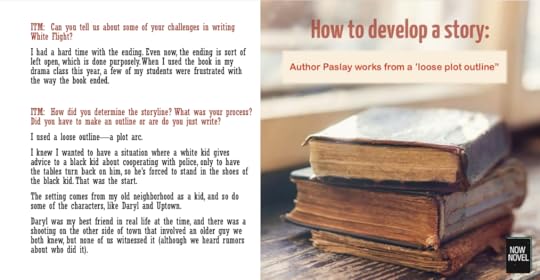

More information on white flight as a phenomenon, check out this article on the Pacific Standard: https://psmag.com/social-justice/whit...
and an article from the Philadelphia Inquirer that Chris mentions: https://inthemarginssite.files.wordpr...
I'll be posting more about Chris over on my website later this week, so stay tuned!
Paslay’s book was written for its readers to learn from the action of the characters in the storyline, which provides powerful impacts on the concepts of friendship and race. Today Chris shares some of his thoughts with us on his background and the inside story of his young adult innovative story.










More information on white flight as a phenomenon, check out this article on the Pacific Standard: https://psmag.com/social-justice/whit...
and an article from the Philadelphia Inquirer that Chris mentions: https://inthemarginssite.files.wordpr...
I'll be posting more about Chris over on my website later this week, so stay tuned!
Published on May 10, 2018 05:45
•
Tags:
awards, friendship, in-the-margins, itm, paslay, race, top-ten, white-flight, young-adult-fiction
When Daronte's Father Went to Prison - In the Margins Blog Tour
Come with us as we reveal the long-awaited interview of author Kim Ballou, author of When Daronte's Father Went to Prison as part of the In the Margins blog tour this month.
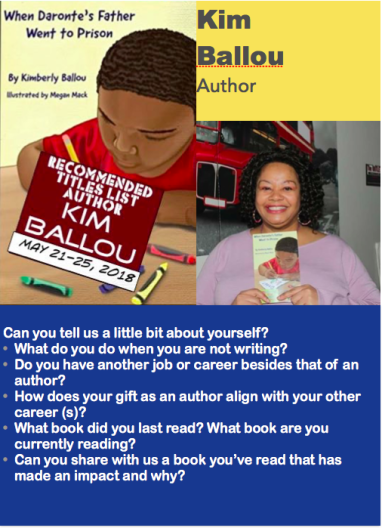
KB: When I'm not writing, I'm usually reading! I also enjoy nature walks—I'm a biology geek, and what better way is there to see biology in action?
My other career is an educator.I'm a former fourth-grade teacher, and now I create practice questions and answer explanations for an online learning bank. I love teaching in all its different forms and my writing reflects it. I hope everyone gains a new perspective from some aspect of my writing.
I use my writing to bring up elements that readers may not have considered—for example, many people wouldn't think that a drug dealer could possibly be a decent parent. As an educator, I want people to think critically about situations and ask questions rather than being "spoon-fed" information. What makes someone a good parent? Can a person break the law and still be a good parent? Is it acceptable for a child to love a parent who has made some really bad decisions? How can we, as a society, give the child space to love his or her parent, while still condemning the parent's behavior? These are the deeper questions I would love for people to address.

ITM: What were some of your earliest memories of writing that you enjoyed?
KB: I've been an avid writer since I was a young child. After acting onstage for several years, I wrote my first play when I was nine years old. It was a Christmas play about a family's adventures preparing for the holiday season, and it featured many of the "standard" children's Christmas songs, like "Rudolph the Red-Nosed Reindeer" and "Frosty the Snowman." It was cute, and I was SO proud!
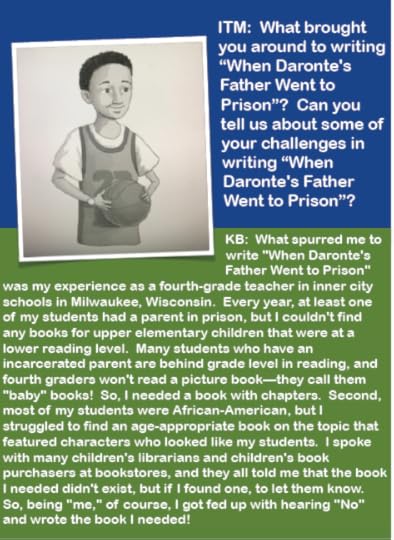
ITM: What brought you around to writing When Daronte's Father Went to Prison? Can you tell us about some of your challenges in writing When Daronte's Father Went to Prison?
KB: What spurred me to write When Daronte's Father Went to Prison was my experience as a fourth-grade teacher in inner city schools in Milwaukee, Wisconsin.
"Every year, at least one of my students Screen Shot 2018-05-21 at 11.52.35 AMhad a parent in prison, but I couldn't find any books for upper elementary children that were at a lower reading level."
Many students who have an incarcerated parent are behind grade level in reading, and fourth graders won't read a picture book—they call them "baby" books! So, I needed a book with chapters.
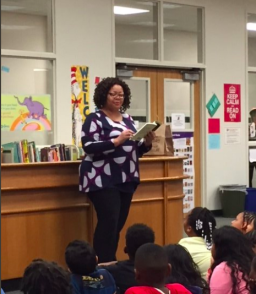
"Second, most of my students were African-American, but I struggled to find an age-appropriate book on the topic that featured characters who looked like my students."
I spoke with many children's librarians and children's book purchasers at bookstores, and they all told me that the book I needed didn't exist, but if I found one, to let them know. So, being "me," of course, I got fed up with hearing "No" and wrote the book I needed!
ITM: How did you determine the storyline? What was your process? Did you have to make an outline or are do you just write?
KB: I knew I wanted the book to have some positive messages without being "preachy." I used information given to me by my student—like the raid scene—for many of the key details in the book. I "fleshed out" some of the descriptions by drawing upon my own experience growing up in Gary, Indiana, walking past drug houses every day to get to school. I wanted my characters to seem like real, normal people rather than saints or monsters. Finally, I knew that Daronte needed a journey, something that changed him and made him grow. How Daronte came to accept and forgive his father's crime provided the reason for that journey. As I mentioned, I've been an actress since I was six years old—I'm very familiar with the way a story needs to "travel" from a starting point to the end of the road (story). I put ALL these elements together and just started writing. I ended up with the first draft of my book. Then, after 6,237 (ish) revisions and read-throughs, When Daronte's Father Went to Prison was ready to be published!
ITM: One of the most impactful frameworks that undergird your storyline is the middle-class lifestyle of Daronte and his family. What inspired you to present Daronte as middle class? What did you know of the consequences suffered by Daronte and children like him? How are middle-class youth different or similar to youth that experiences the same thing but are from lower income levels? In your experience, what have you seeded the most of from children who experience this trauma: middle-class youth? Lower-income youth?
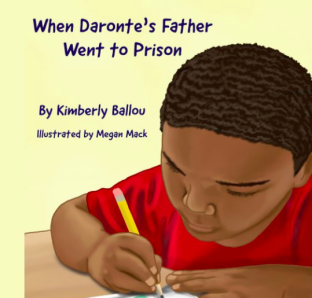
KB: I have met drug dealers personally—some were my students' parents, and others were people I knew when I was growing up in Gary. Many of them lived what's now called a "Bad and Bougie" lifestyle: one in which their roots and their income remain based on the street lifestyle, but the face they present to the world can be middle-class. Daronte didn't know a street life, but in their backstory, his parents were low-income people who lived a street life until drug money raised their socioeconomic status.
"In this way, the difference between low-income and middle-class is not a true distinction—this particular group straddles the line between them. "
My experience of the consequences to the children who experience this trauma involves children who inhabit this "shadow" world, and once the money is gone, they suffer the xsame poverty and instability as any other low-income youth.
ITM: The other impactful framework undergirding your storyline is the phenomenon of young black boys having guns pulled on themselves by authority figures. How bad is this affecting communities in the areas you teach? In the schools in the area? Do you see this phenomenon occurring with different ethnic groups?
KB: When I was a teenager and began going out with my friends, my mother told me what to do in case we were stopped by the police: hands visible, don't run, speak respectfully, and move slowly. That's what it was like when I was a TEENAGER—the youngest child who told me about a raid at his house was five years old. And yes, he said the officers pointed their guns at him. Don't misunderstand me: police officers have a tough, dangerous job, and I've worked with wonderful officers of different ethnicities who try hard to make a positive difference in the communities they protect.
"But pointing a semi-automatic weapon at a five-year-old can never be acceptable. Where's the imminent threat?"
My students who experienced this type of behavior by the police just felt increased animosity toward and distrust of police officers. How do you convince a nine-year-old to trust officers when a group of them burst into his home and pointed a gun at him? To a nine-year-old, those officers represent ALL officers at all times, and there is no way to erase that deep impression on one so young.

ITM: What was your favorite chapter (or part) of the When Daronte's Father Went to Prison storyline and why?
KB: My favorite chapter to write was Chapter Two because it challenged me to express all the emotions that my students felt during their terrifying experiences! My favorite part to read is in Chapter Six when Daronte is dealing with the nosy neighbor, Mrs. Carr. I think everyone knows someone like Mrs. Carr—she cracks me up!
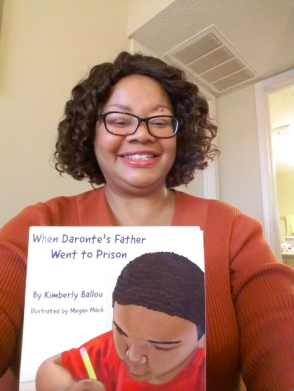
ITM: What has been the toughest criticism given to you as an author? What has been the best compliment?
KB: After all the proofreading, read-throughs and editing I had done, a reader noticed a mistake. It hurt my little perfectionist's heart! The biggest compliment happened when I conducted a little experiment at an airport. A young African-American boy, about 11 years old, sat across from me, listening to music on headphones and playing games on an iPad. He was dancing along to the music while in his seat. I pulled out a copy of When Daronte's Father Went to Prison and held it up, pretending to read while watching him. He eventually glanced around, noticed the book's cover and did a double-take! He then leaned all the way over in his chair to read the title. His reaction has been my best compliment so far. He had to board the plane before we could chat, but this experiment drove home to me the need for African-American children to see themselves represented in books. It should be a normal occurrence rather than something that causes a double-take.
ITM: Do you have any advice to give to aspiring writers?
KB: I say to aspiring writers, "Keep perfecting your craft." It's not enough to write your ideas—you need feedback from other writers to improve. Join local writing groups and workshops. Learn how to accept criticism of your work and use the feedback to make your craft better. Writing is a marathon, not a sprint.
ITM: Are you working on a new book title? Can you share with us what the title is and when it will be due?
KB: I am currently working on my second middle-grade book, tentatively titled, "Aniyah and the Albatross." It is due out in November 2018.
KB: Is there anything that you would like to say to your readers and fans?
ITM: Everyone, please be on the lookout for my author website, coming soon. You'll find pictures and links to interviews, as well as blog posts and other extras for parents and educators. Thank you all so much for buying and supporting When Daronte's Father Went to Prison You can find it on Amazon.com. I hope it makes you laugh, makes you think, and helps children see that no matter how bad things are, there's always hope!
Follow Kimberly Ballou on Amazon: https://amzn.to/2KLJH5F
LinkedIn: https://bit.ly/2LlQp3E
Facebook: https://bit.ly/2GGLxSX

KB: When I'm not writing, I'm usually reading! I also enjoy nature walks—I'm a biology geek, and what better way is there to see biology in action?
My other career is an educator.I'm a former fourth-grade teacher, and now I create practice questions and answer explanations for an online learning bank. I love teaching in all its different forms and my writing reflects it. I hope everyone gains a new perspective from some aspect of my writing.
I use my writing to bring up elements that readers may not have considered—for example, many people wouldn't think that a drug dealer could possibly be a decent parent. As an educator, I want people to think critically about situations and ask questions rather than being "spoon-fed" information. What makes someone a good parent? Can a person break the law and still be a good parent? Is it acceptable for a child to love a parent who has made some really bad decisions? How can we, as a society, give the child space to love his or her parent, while still condemning the parent's behavior? These are the deeper questions I would love for people to address.

ITM: What were some of your earliest memories of writing that you enjoyed?
KB: I've been an avid writer since I was a young child. After acting onstage for several years, I wrote my first play when I was nine years old. It was a Christmas play about a family's adventures preparing for the holiday season, and it featured many of the "standard" children's Christmas songs, like "Rudolph the Red-Nosed Reindeer" and "Frosty the Snowman." It was cute, and I was SO proud!

ITM: What brought you around to writing When Daronte's Father Went to Prison? Can you tell us about some of your challenges in writing When Daronte's Father Went to Prison?
KB: What spurred me to write When Daronte's Father Went to Prison was my experience as a fourth-grade teacher in inner city schools in Milwaukee, Wisconsin.
"Every year, at least one of my students Screen Shot 2018-05-21 at 11.52.35 AMhad a parent in prison, but I couldn't find any books for upper elementary children that were at a lower reading level."
Many students who have an incarcerated parent are behind grade level in reading, and fourth graders won't read a picture book—they call them "baby" books! So, I needed a book with chapters.

"Second, most of my students were African-American, but I struggled to find an age-appropriate book on the topic that featured characters who looked like my students."
I spoke with many children's librarians and children's book purchasers at bookstores, and they all told me that the book I needed didn't exist, but if I found one, to let them know. So, being "me," of course, I got fed up with hearing "No" and wrote the book I needed!
ITM: How did you determine the storyline? What was your process? Did you have to make an outline or are do you just write?
KB: I knew I wanted the book to have some positive messages without being "preachy." I used information given to me by my student—like the raid scene—for many of the key details in the book. I "fleshed out" some of the descriptions by drawing upon my own experience growing up in Gary, Indiana, walking past drug houses every day to get to school. I wanted my characters to seem like real, normal people rather than saints or monsters. Finally, I knew that Daronte needed a journey, something that changed him and made him grow. How Daronte came to accept and forgive his father's crime provided the reason for that journey. As I mentioned, I've been an actress since I was six years old—I'm very familiar with the way a story needs to "travel" from a starting point to the end of the road (story). I put ALL these elements together and just started writing. I ended up with the first draft of my book. Then, after 6,237 (ish) revisions and read-throughs, When Daronte's Father Went to Prison was ready to be published!
ITM: One of the most impactful frameworks that undergird your storyline is the middle-class lifestyle of Daronte and his family. What inspired you to present Daronte as middle class? What did you know of the consequences suffered by Daronte and children like him? How are middle-class youth different or similar to youth that experiences the same thing but are from lower income levels? In your experience, what have you seeded the most of from children who experience this trauma: middle-class youth? Lower-income youth?

KB: I have met drug dealers personally—some were my students' parents, and others were people I knew when I was growing up in Gary. Many of them lived what's now called a "Bad and Bougie" lifestyle: one in which their roots and their income remain based on the street lifestyle, but the face they present to the world can be middle-class. Daronte didn't know a street life, but in their backstory, his parents were low-income people who lived a street life until drug money raised their socioeconomic status.
"In this way, the difference between low-income and middle-class is not a true distinction—this particular group straddles the line between them. "
My experience of the consequences to the children who experience this trauma involves children who inhabit this "shadow" world, and once the money is gone, they suffer the xsame poverty and instability as any other low-income youth.
ITM: The other impactful framework undergirding your storyline is the phenomenon of young black boys having guns pulled on themselves by authority figures. How bad is this affecting communities in the areas you teach? In the schools in the area? Do you see this phenomenon occurring with different ethnic groups?
KB: When I was a teenager and began going out with my friends, my mother told me what to do in case we were stopped by the police: hands visible, don't run, speak respectfully, and move slowly. That's what it was like when I was a TEENAGER—the youngest child who told me about a raid at his house was five years old. And yes, he said the officers pointed their guns at him. Don't misunderstand me: police officers have a tough, dangerous job, and I've worked with wonderful officers of different ethnicities who try hard to make a positive difference in the communities they protect.
"But pointing a semi-automatic weapon at a five-year-old can never be acceptable. Where's the imminent threat?"
My students who experienced this type of behavior by the police just felt increased animosity toward and distrust of police officers. How do you convince a nine-year-old to trust officers when a group of them burst into his home and pointed a gun at him? To a nine-year-old, those officers represent ALL officers at all times, and there is no way to erase that deep impression on one so young.

ITM: What was your favorite chapter (or part) of the When Daronte's Father Went to Prison storyline and why?
KB: My favorite chapter to write was Chapter Two because it challenged me to express all the emotions that my students felt during their terrifying experiences! My favorite part to read is in Chapter Six when Daronte is dealing with the nosy neighbor, Mrs. Carr. I think everyone knows someone like Mrs. Carr—she cracks me up!

ITM: What has been the toughest criticism given to you as an author? What has been the best compliment?
KB: After all the proofreading, read-throughs and editing I had done, a reader noticed a mistake. It hurt my little perfectionist's heart! The biggest compliment happened when I conducted a little experiment at an airport. A young African-American boy, about 11 years old, sat across from me, listening to music on headphones and playing games on an iPad. He was dancing along to the music while in his seat. I pulled out a copy of When Daronte's Father Went to Prison and held it up, pretending to read while watching him. He eventually glanced around, noticed the book's cover and did a double-take! He then leaned all the way over in his chair to read the title. His reaction has been my best compliment so far. He had to board the plane before we could chat, but this experiment drove home to me the need for African-American children to see themselves represented in books. It should be a normal occurrence rather than something that causes a double-take.
ITM: Do you have any advice to give to aspiring writers?
KB: I say to aspiring writers, "Keep perfecting your craft." It's not enough to write your ideas—you need feedback from other writers to improve. Join local writing groups and workshops. Learn how to accept criticism of your work and use the feedback to make your craft better. Writing is a marathon, not a sprint.
ITM: Are you working on a new book title? Can you share with us what the title is and when it will be due?
KB: I am currently working on my second middle-grade book, tentatively titled, "Aniyah and the Albatross." It is due out in November 2018.
KB: Is there anything that you would like to say to your readers and fans?
ITM: Everyone, please be on the lookout for my author website, coming soon. You'll find pictures and links to interviews, as well as blog posts and other extras for parents and educators. Thank you all so much for buying and supporting When Daronte's Father Went to Prison You can find it on Amazon.com. I hope it makes you laugh, makes you think, and helps children see that no matter how bad things are, there's always hope!
Follow Kimberly Ballou on Amazon: https://amzn.to/2KLJH5F
LinkedIn: https://bit.ly/2LlQp3E
Facebook: https://bit.ly/2GGLxSX
Published on May 24, 2018 03:31
•
Tags:
book-awards, children, families, in-the-margins, itm, kidlit, marginalization, picture-books, prison, relationships
Insightful New Review of That Night
I woke up to an incredibly insightful and provocative review of That Night by librarian Sabrina Carnesi, who is also on the In the Margins national book committee, which longlisted That Night earlier this year.
https://brichislitspot.blog/2018/07/2...
Ms. Carnesi gets all the gritty details of the problems going on that lead to Kayla's death, and how the adults and society in general are missing these issues in real life - which is what led me to write this heartbreaking story.
Thank you so much to Sabrina and the ITM committee for bringing That Night to the attention of readers, teachers, parents, and librarians!
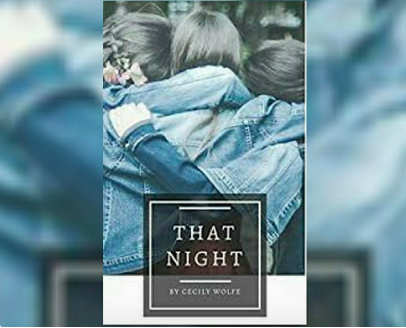
https://brichislitspot.blog/2018/07/2...
Ms. Carnesi gets all the gritty details of the problems going on that lead to Kayla's death, and how the adults and society in general are missing these issues in real life - which is what led me to write this heartbreaking story.
Thank you so much to Sabrina and the ITM committee for bringing That Night to the attention of readers, teachers, parents, and librarians!

Published on July 24, 2018 06:05
•
Tags:
book-review, death, high-school, in-the-margins, mourning, opioid-epidemic, teen-fiction, ya-fiction
In the Margins Award - The Competition
I am so thrilled that The Competition is included on the In the Margins Award recommend list for 2019!

Last year, That Night made the longlist for this national award, which recognizes books for youth and young adults who are marginalized by situation, class, or race - poverty, abuse, incarceration, and homelessness are some of the situations addressed in the books on their lists.
In The Competition, Mary Sofia is a Puerto Rican American teen who comes from a background of family violence, and lives in a shelter for teens while dreaming of visiting her beloved older brother, who is in state prison.
Thank you to the ITM Committee for helping Mary Sofia's story reach new readers!

Last year, That Night made the longlist for this national award, which recognizes books for youth and young adults who are marginalized by situation, class, or race - poverty, abuse, incarceration, and homelessness are some of the situations addressed in the books on their lists.
In The Competition, Mary Sofia is a Puerto Rican American teen who comes from a background of family violence, and lives in a shelter for teens while dreaming of visiting her beloved older brother, who is in state prison.
Thank you to the ITM Committee for helping Mary Sofia's story reach new readers!
Published on February 06, 2019 07:14
•
Tags:
award, award-winning, in-the-margins, young-adult-fiction



